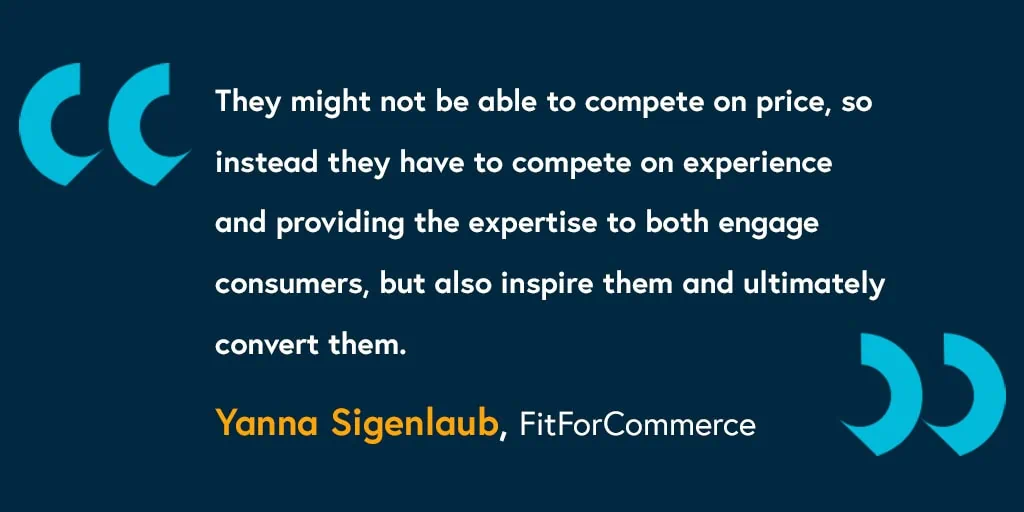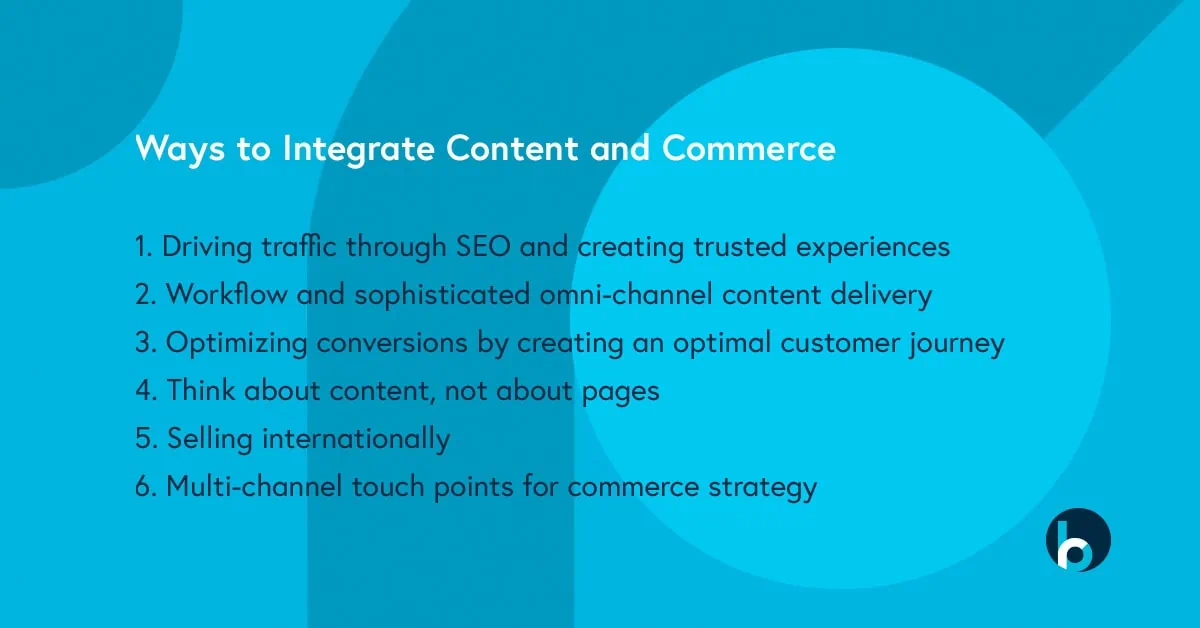The digital commerce landscape is rapidly changing. Customer expectations are rising every day and in order to stay competitive. Businesses must be able to adapt quickly and need the right tools to do so.
Until recently, most eCommerce players would purchase a standard solution such as SAP Hybris, Intershop or WCS to drive their online commerce environment.
These tools are good for building category pages and product pages, but are very limited when it comes to managing and injecting additional content into the digital experience.
In the age of big online marketplaces, online businesses need to offer more than a nice set of products to attract and convert visitors.
They need to build a relationship with their customers by telling a story and offering valuable content in a seamless customer journey.
Creating Differentiated Experience with Content in eCommerce
When people compare products from different sellers on the web, competing on pricing alone isn’t feasible for most businesses.
One major way that businesses are now gaining a competitive advantage in digital is by providing a seamless customer journey that establishes a lasting relationship with the customer.
Delivering this consistent cross-channel experience involves synchronizing personal data and shopping carts across all touchpoints.
But to really engage with them, you’ll need to offer valuable content like how to videos, tips & tricks, and inspirational pieces.
Building a meaningful customer experience is important for all retailers, brands and manufacturers, whether they are selling directly to consumers or to other enterprises.
The true differentiation for tomorrow’s eCommerce is when you marry the best of both of these worlds — content and commerce — and personalize them both for each consumer in the moment.
Providing the right content for all those people, at just the right point in their individual shopping processes is a big job — especially when you consider the multitude of different devices and marketing channels that consumers interact with throughout the day.
Like many big jobs, the best way to tackle it is to take it a piece at a time.
6 Ways to Integrate Content and Commerce
[Way #1] Driving traffic through SEO and creating trusted experiences
Step one is having the customer find the site. Next comes building the engagement and trust that will lead to an actual purchase.
- Driving traffic:
In order to drive relevant traffic to a site, retailers must produce enough high quality content to become a valuable and trusted source for consumers.
Sites that rely on natural language processing and webwide search queries to continually learn and keep up with changes in vocabulary, seasons, trends, and consumer habits are particularly well-suited to serve today’s demanding consumer.
- Trusted experiences:
Digital experiences should become more personal once you’ve actually attracted a customer to your site.
One way to achieve this is serving the right piece of content to the right person, depending on where they are in their buying process, for instance.
If visitors click on a link on any of your online store channels, a true web engagement management platform will use this information in real-time to optimize what the visitor sees next.
Information from their social profile (Twitter, Facebook and LinkedIn), from their device (mobile or desktop), their location, their behavior and of course what the store knows about that user will be used to make their experience more enriched and relevant.
And the system should learn, every day, how to continually provide better results as it delivers an automated set of experience and data insight to the managers to create different content.
[Way #2] Workflow and sophisticated omnichannel content delivery
Certainly managing content isn’t a new requirement for eCommerce systems. In fact, many eCommerce software systems rival some content management systems in their ability to produce normalized content to different channels.
But the fact is that most eCommerce systems have not been built to handle multiple workflows for managing content channels.
This is where it becomes critical to combine the commerce platform with a powerful content management system to create a single digital experience platform that can drive these optimized, multi-channel experiences.
Savvy eCommerce businesses think about content workflow, user management across different locations, link management, A/B testing and more flexible management of digital content experiences across every content channel.
These requirements in turn require a much more integrated solution of both eCommerce and content management.
[Way #3] Optimizing conversions by creating an optimal customer journey
Some buyers use their carts as wish lists, or they may be holding out for discounts to come online. Either way, the eCommerce manager’s job is to get these shoppers to convert into buyers.
The key to reducing abandonment in shopping carts is to follow up on that abandonment.
A properly timed email is a proven strategy, with eMarketer reporting that more than 20 percent of those who abandoned carts will convert if sent an email within an hour of the abandonment.
But increasingly the ability to serve up personalized, direct and targeted content across any channel is the key to delivering that reminder successfully.
This is where an integrated content management solution can become a holistic solution for targeting this content.
No question a robust digital experience platform should include the ability to deliver a truly relevant, personalized approach to content across any channel.
[Way #4] Think about content, not about pages
Many retailers start out designing their site thinking they know the personas they want to serve – and believing that they can predict the specific paths to purchase each persona will take to conversion.
This almost always results in a less-than-satisfying customer experience.
These retailers are taking the page-oriented view of eCommerce, instead of the Content-as-a-Service concept of today’s digital experience platform.
For instance, instead of forcing users into an assumed hierarchy of content, smart marketers are using sophisticated content management systems, including faceted navigation, to have their content dynamically assume a hierarchy as the content is consumed.
This way, each shopper determines his or her own journey – and there are innumerable ways that they can provide a customized journey to their desired end point.
[Way #5] Selling internationally
As the world becomes a smaller place, eCommerce enterprises are finding that there are vast numbers of new customers waiting for them overseas.
As we’ve said, depending on which country you’re selling in, another nearby country may be growing at a much faster rate.
Getting a competitive advantage early in developing countries can truly help differentiate you from your competition. But of course operating an international site brings its own set of challenges.
We won’t go into the different laws, shipping and currency issues that you’ll also want to explore – but from a content perspective, you should make sure that your content management system can handle delivery of content across any language – and that it makes it as easy as possible to set up a new international channel for your products.
Smart marketing organizations will deploy web content management technology that focuses on global brand management – with the ability to manage localized content at a channel level.
In order to provide a memorable customer experience, marketers need to ensure that they are using certain content management features.
[Way #6] Multi-channel touch points for commerce strategy
Establishing a centralized way to manage product offers, catalogs and all manner of personalized content across social networks like Facebook, Twitter, Pinterest and Instagram is essential for eCommerce stores.
Most content management system and eCommerce solution vendors today will claim they can deliver content to multiple channels.
This, of course, includes mobile content delivery. But making sure that your content is separated from the presentation is critical.
And, making sure that you can easily add mobile channels to your strategy is also very important. In other words, the harder it is to set up a new mobile channel for your web content, the less likely you are to do it
Where to Start: Content and Commerce Integration
eCommerce platforms are good at working with product data. They are specifically designed to manage large catalogs containing data points like pricing, product hierarchy and product variations.
CMSs, on the other hand are better suited for managing rich web content: images, videos, graphs, reviews, guides and the like. In keeping with the principle of separation of concerns, your product data should reside in your ecommerce platform while your web content should be in your CMS.
The easiest way to get started with combining eCommerce and content management into a single platform is to take the headless approach.
The goal is to go for the digital experience platform to seamlessly work with the eCommerce (transactional) software, while maintaining visibility of the end-to-end customer journey: customer data, CRM engagement, purchase history and beyond.
Bloomreach Experience Cloud is built specifically to deliver best-in-class B2B and B2C content & commerce experiences.
Bloomreach Experience Cloud has all the advantages of a headless CMS plus powerful marketing and merchant tools like preview, in-line editing, AI-powered search, personalization, optimization, and A/B/n testing and build unique experiences to grow and innovate faster.















